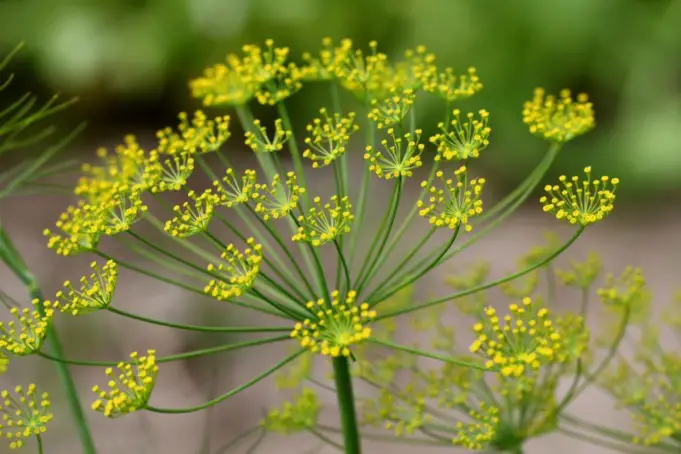Dill is native to East, Persia and India. The scientific name of this herb is Anethum graveolens and belongs to the plant family Apiaceae.
This herb is an annual herb, known desire antiquity. Dill living in rustic camps and steppe at low altitudes, up to 500-600 m., prefers sunny spots, and needs well-drained moist soil.
Anethum graveolens is an aromatic plant, measuring 30 cm. more than one meter in height. Its green stem, long, hollow, and has grooves along which give it a white and green hue.
The leaves of this herb are very thin and dark green. The fruits are dark brown 5 mm. Dill flowers are yellow. Its leaves and fruits are used in cooking as spices, and seeds, very similar to those of parsley, are used in the preparation of medicinal teas.
Among the common names of Anethum graveolens, we can find, Dill (as before he was appointed, drowns, dill, anella, anetaveron, dill, avezon domestic stinking fennel.
Anethum graveolens is used in the kitchen and is compatible with all other herbs are used fresh. It is an herb widely used in Scandinavian cuisine: very important ingredient of marinated salmon.
The fresh leaves of this plant are used in salads, fish dishes and sauces to accompany fish. Its seeds are used primarily to flavor pickles and vinegar can be added to cakes, breads, fish and rice dishes.
resh flowers and fruit of this plant are used to prepare pickles and dill to make vinegar. Among the medicinal properties of this plant are that stimulates digestive secretions and is used against flatulence and dyspepsia.
It is recommended in cases of spasmodic hiccups, uterine cramps, menstrual cramps, flatulence, gastrointestinal spasms, breast, burns, skin ulcerations, carminative, and provokes urine, and antiseptic.
This herb is composed of essential oils and essential oil that is rich in limonene, eugenol and anethole, among others, that such actions give carminative, so it is very convenient in cases of flatulence and heartburn caused by foods difficult to digest.
Its content of coumarins, flavonoids and caffeic acid and chlorogenic give lactogogue properties, that is, it increases the formation of breast milk.
Recipes for this herb:
Infusion: to prepare an infusion of 20 r. Dill seeds per liter of water. It should take 3 cups per day, and is used as a digestive and carminative.
In external use the seeds of this herb have emollient and antiphlogistic. Bath is heated to a pint of olive oil with a tablespoon of seeds, keeps a low heat for 1 hour. Apply warm over boils, pimples, etc. Soothes the pain and helps rapid maturation.
Tincture: you can make excellent digestive Dill making a tincture with 200 cc alcohol of 60 º and 40 gr. seeds of this herb. It is advisable to dissolve one teaspoon in coffee or tea to be taken after meals.












